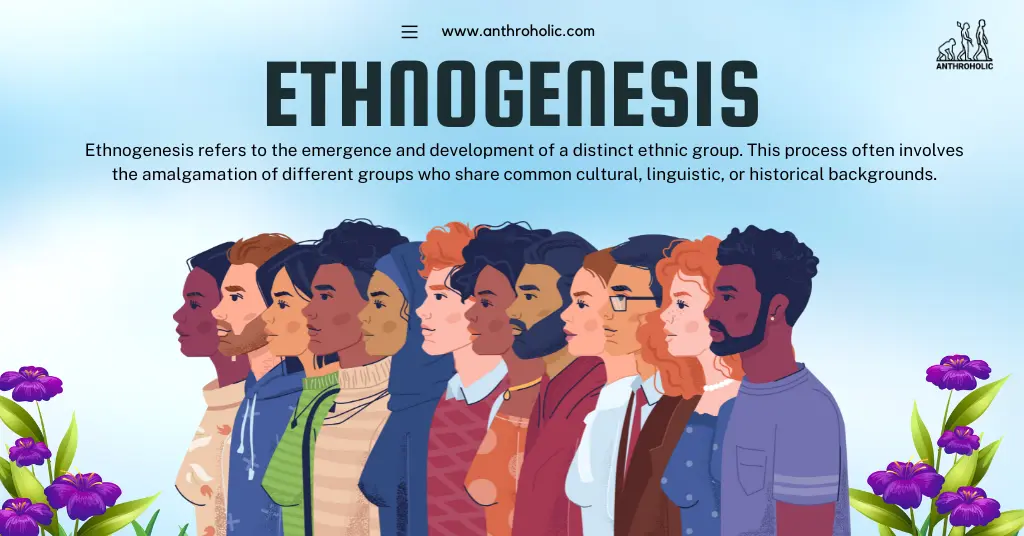AI Answer Evaluation Platform Live Now. Try Free Answer Evaluation Now
Ethnogenesis
Ethnogenesis is a complex and intriguing concept that pertains to the formation and development of an ethnic group. This process, which draws heavily from historical, sociological, and anthropological domains, is instrumental in our understanding of cultural and societal dynamics. This article delves into the concept, its mechanisms, and the role it plays in shaping human societies.

Understanding Ethnogenesis
Ethnogenesis refers to the emergence and development of a distinct ethnic group. This process often involves the amalgamation of different groups who share common cultural, linguistic, or historical backgrounds. Ethnogenesis can take various forms:
- Merger: Several smaller groups may converge to form a single, larger ethnic group.
- Fission: An existing group may split into two or more separate ethnic groups.
- Transformation: A group may change so significantly over time that it eventually forms a new ethnic group.
Mechanisms of Ethnogenesis
Ethnogenesis is not a haphazard phenomenon. It is spurred and shaped by several key mechanisms:
- Migration and Settlement: The relocation of people from one region to another, often for reasons such as war, trade, or exploration, can birth new ethnic groups.
- Cultural Innovation: The introduction of novel cultural practices, languages, or religions can foster the development of new ethnic groups.
- Interactions with Other Groups: Contact and interaction with other ethnic groups can lead to cultural borrowing, adaptation, and the creation of new identities.
Case Studies: Ethnogenesis in Action
The Franks
The Franks, an ancient Germanic people, exemplify the process of ethnogenesis through merger. Composed of various smaller tribes, the Franks coalesced into a larger, united entity around the 3rd century AD [1].
The Scots
The Scots are an example of ethnogenesis through transformation. The original Scots, who migrated from Ireland to Scotland in the 5th century AD, gradually adopted the local culture, language, and identity, eventually evolving into the Scottish ethnic group known today [2].
Implications of Ethnogenesis
Understanding ethnogenesis can provide insights into various societal phenomena:
- Nationalism: The construction of national identity often leans on narratives of shared ethnic heritage, which can be traced back to processes of ethnogenesis.
- Inter-Ethnic Conflicts: Tensions between ethnic groups can be better understood by examining their historical development and interactions.
- Cultural Evolution: Ethnogenesis shows how cultures evolve, mix, and differentiate over time, offering a dynamic view of human societies.
Examples of Ethnogenesis
1. The Birth of the French Nation
The French nation emerged from the complex interplay of different tribal groups that migrated into what is now France over centuries. This included Romans, Gauls, and Germanic Franks, among others. The Franks, particularly under the rule of Charlemagne, helped to unify these diverse groups under one administrative umbrella, leading to the eventual creation of the French nation and French identity [1].
2. Formation of the Russian Ethnic Identity
The Russian ethnic identity emerged through a long process of assimilation and adaptation between Slavic, Finno-Ugric, and Turkic groups. This process, which began around the 9th century AD with the establishment of the Kievan Rus’, led to the development of the Russian language, the Orthodox Christian faith, and other components of the Russian ethnic identity [2].
3. Creation of the Japanese People
The Japanese people resulted from the merger of the indigenous Jomon people and the Yayoi people who migrated from the Korean Peninsula around 300 BCE. These two groups intermingled over several centuries, contributing to the formation of a distinct Japanese ethnic identity characterized by a unique language, religion (Shinto), and set of cultural practices [3].
4. Emergence of the American Identity
The American identity is a product of ethnogenesis involving various immigrant groups. English settlers, African slaves, and indigenous peoples formed the foundational ethnic groups. Over centuries, successive waves of immigrants from Europe, Asia, Latin America, and other regions contributed to the formation and evolution of the American identity. This process is ongoing, with new immigrants continuing to shape the multifaceted and diverse American identity [4].
5. Development of the Han Chinese
The Han Chinese, constituting the world’s largest ethnic group, emerged from the fusion of several ancient tribes in the Yellow River region. Over time, these tribes, under the influence of the Han Dynasty (206 BCE – 220 CE), merged and formed a unified Han Chinese identity. This process involved the adoption of a common language (Old Chinese), shared cultural practices, and a centralized political system [5].
Conclusion
Ethnogenesis is a crucial concept that provides valuable insights into the formation and evolution of human societies. By tracing the origins and development of ethnic groups, we can gain a deeper understanding of cultural diversity, societal dynamics, and human history.
References
[1] Geary, Patrick J. Before France and Germany: The Creation and Transformation of the Merovingian World. Oxford University Press, 1988. https://archive.org/details/beforefrancegerm0000gear
[2] Broun, Dauvit. “The Birth of Scottish Identity: A Reassessment.” The Scottish Historical Review, vol. 79, no. 207, 2000, pp. 3-37.
[3] Jones, Colin. The Cambridge Illustrated History of France. Cambridge University Press, 1999.
[4] Martin, Janet. Medieval Russia, 980-1584. Cambridge University Press, 2007.
[5] Diamond, Jared. Japan: Until Death Do Us Part. Discovery Channel, 2005.
[6] Huntington, Samuel P. Who Are We? The Challenges to America’s National Identity. Simon & Schuster, 2004.
[7] Ebrey, Patricia Buckley. The Cambridge Illustrated History of China. Cambridge University Press, 2010.




